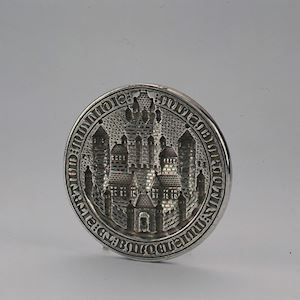
06. Great seal and reverse side
This great seal and its reverse side from 1343 are the most important symbols of dignity in the city of Zutphen. They were used by the two mayors of Zutphen to formalize and seal important decisions. Two mayors? Oh yes, with city rights came many privileges and requirements. Zutphen was thereby one of the most important cities in Gelderland. By appointing two mayors, it prevented one man having too much power. The seals belong to the oldest silver pieces in the museum’s collection. On the large seal, you can see an image with many towers. This refers to Zutphen as tower city. On the smaller reverse side is the coat of arms of Zutphen from that time: a climbing lion with an anker cross. It was exceptionally large, showing the important position of the city. Zutphen acquired city rights around 1195 from Count Otto the first. The privileges that the city obtained brought great prosperity. As a result, there was an exemption from toll for foreigners, who plied their trade in Zutphen, and this attracted many traders to the city. In addition, the city received autonomy and its own justice system. This justice system in the Middle Ages was not so humane. Executions, brandings and handcuffs were regularly used.


The Musea Zutphen -Stedelijk Museum Zutphen en het Museum Henriette Polak- are located in the 17th-century city palace Hof van Heeckeren. History, cultural history, visual arts and topical matters meet here in a surprising way
- 's Gravenhof 4
- Zutphen Netherlands
- 0575516878
- www.museazutphen.nl
